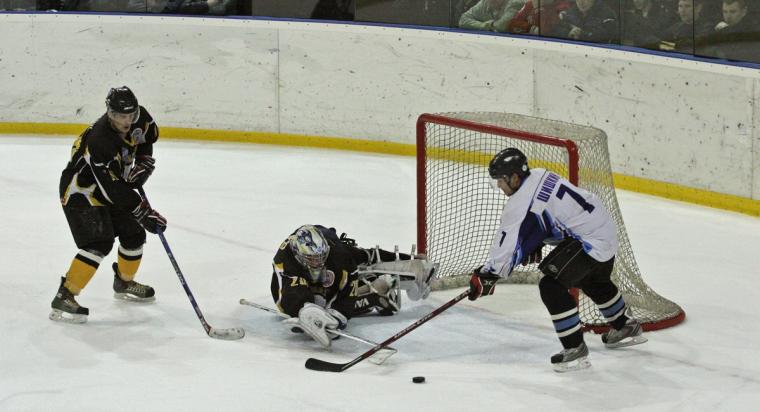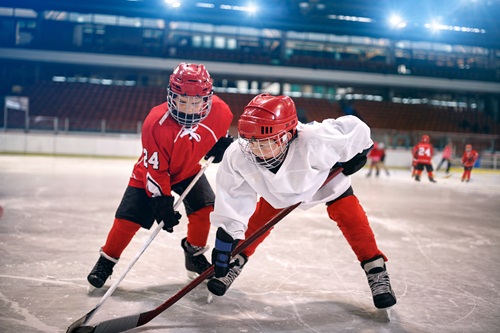
Sometimes, to track safety concerns in sports, all you need to do is consult autofill.
When Damar Hamlin’s on-field cardiac arrest occurred earlier in the year, once you typed in “chest,” autofill helpfully added the rest of the word: protection, and sometimes suggested an expansion to “chest protection in football.” Now, with the death of former NHL player Adam Johnson, following a skate cut to the throat, type in “neck” and you get “neck protection for ice hockey.”
Johnson was playing for the Nottingham Panthers in England's Elite Ice Hockey League (EIHL) when his throat was cut by a skate blade during a collision in Saturday game against the Sheffield Panthers. He died a short time later at a local hospital. It was, by all accounts, a freak accident, but then again, so is commotio cordis, or chest concussion, which Hamlin suffered.
Within days of the event, a measure was passed by the English Ice Hockey Association (EIHA), noting that all ice hockey players in England would be required to wear cut-resistant neck guards starting in 2024. It strongly encouraged the NHL to do the same.
But will it? It sounds logical and certainly reasonable, but unfortunately, perhaps not immediate. The Seattle Times notes, “If history tells us anything, the transition of NHL players to wearing neck protection on a broad scale won’t happen overnight. But if history really does tell us anything, it most certainly will happen. Unfortunately, similar safety evolutions have usually needed death or serious injury to occur first.”
In some places, they’re not waiting for the NHL. Johnson once played for the Pittsburgh Penguins and his death hit local youth hockey hard. Before games could even begin on Monday, the commissioner of the Pennsylvania Interscholastic Hockey League, Tom Halaburka, sent out a memo to every team, on-ice official and game coordinator in the league, reminding them about the protection rules that are in place. Those rules include mandatory mouthpieces and neck guards.
“Some players don’t like to wear them,” Chris Cerutti, a local coach, told reporters at TribLive, “but now they have to learn to adjust.”
For an image of a youth hockey player wearing neck protection, click here.
The interesting question is what will happen next. After all, following the Hamlin incident, schools, clubs and tournament venues wanted to secure AEDs (since one had saved Hamlin’s life.)
But ice hockey… well, as they say in Facebook when describing a relationship, it’s complicated. According to the Minnesota ice hockey resource, TheRinkLive:
“All youth hockey players in Canada have to wear a neck guard. However, youth hockey leagues in the United States that fall under the umbrella of USA Hockey cannot require them because USA Hockey prohibits youth leagues, including Fargo, West Fargo, Moorhead and Grand Forks, from requiring them.”
 It’s a confusing bit of ruling; many organizations in Minnesota (and in other states) strongly suggest them but are unable to mandate them.
It’s a confusing bit of ruling; many organizations in Minnesota (and in other states) strongly suggest them but are unable to mandate them.
In Minnesota, there is another connection: Johnson was a native of that state and got his start playing youth hockey in the Duluth area. Some coaches are old enough to remember his standout performance as a high school athlete before he moved on to college; in fact, it was Johnson's overtime goal against Boston University in the 2017 West Regional Final in Fargo that propelled Minnesota Duluth into the Frozen Four.
Will USA Hockey will take enough heat to rethink its stance? The governing body currently recommends neck protection but it its wording is a weak endorsement at best, since it cites statistics against their effectiveness.
Parents and coaches are frustrated by what they see as a deliberate sidestepping of the issue.
"As much as I wish that we could [mandate protective gear] and I think we should, it's just something we can't do right now," said Moorhead Youth Hockey director Jason Gregoire.
However, according to at least one source, USA Hockey, at long last, says it is gathering information on the subject; reporters at KSTP-TV noted:
USA Hockey’s Safety and Protective Equipment Committee is currently crafting proposals for discussion with amateur and youth hockey’s legislative board. That could include suggesting a possible rule change to require all players to wear neck guards, according to committee chair and chief medical and safety officer Dr. Michael Stuart.
“We are currently in the process of consulting medical experts, evaluating the available science,” Stuart said of the committee that is in an advisory role for USA Hockey. “We will propose very soon our recommendation for a possible rule change.”
He also said USA Hockey officials will consult with the Hockey Equipment Certification Council, or HECC.
A local sporting goods store quoted in the news segment above told reporters they have been selling 20 to 40 neck protectors a day, and that the buzz among shoppers indicates a strong level of parental concern.
The NHL does not currently mandate neck protection either; The Guardian notes: “But accidents happen [in the NHL] too. In 1989, the Buffalo Sabres goaltender Clint Malarchuk had his throat slashed by a skate during a game against the St Louis Blues after two players crashed his net. He received 300 stitches but returned to the ice within two weeks. In 2008, Richard Zednik’s throat was accidentally cut by a Florida Panther teammate’s errant skate during a game against the Sabres. Zednik recovered but missed the remainder of the season.
In all that time, only two NHL players wore neck coverings of any kind. One was Tomas Plekanec, whose turtleneck earned him ridicule. The other was Wayne Gretzky. In 2020, Moritz Seider, now with the Detroit Red Wings, was playing in Sweden when a neck guard saved him from a potentially horrific skate laceration. Three years later, the NHL defenseman goes without one.
By and large, the NHL and its players have been notoriously slow to adopt safety measures. They eschewed goalie masks for decades, gradually wore helmets only after a 1979 mandate was imposed and glacially adopted (and began abiding by) stricter rules for dangerous hits such as those to the head. This resistance to safety lies partly in the NHL’s history and mindset, which is representative of a broader mentality in the sport, especially in North America. It is proud of the danger inherent in the game.”
But it’s not just hockey. Attempts to mandate protective gear in other sports have been met with not just resistance but ridicule and outright refusal, and with statements that safety equipment will change the game and create weaker athletes. Pediatricians have been trying to get governing bodies to mandate helmets in girls’ and women’s lacrosse for years, just as they have been trying to get them to mandate head protection in youth soccer. NFHS Field Hockey rules, which require its goalies to wear a full face/cage mask-helmet which covers the entire head including the back of the head, note only that for all other players, “medical required head coverings must be approved by state association.”
In 2015, pro soccer player Ali Krieger made headlines (heh) when she became the first player on the USWNT to choose performance headgear. In addition to Krieger, players from Mexico, Ecuador, New Zealand and other nations began wearing the piece of equipment, which looked like a padded headband. Carli Lloyd also began wearing the device.
While events owners of professional cycling sports (including bicycling and BMX) require helmets, there is no congruity nationwide among states when it comes to recreational cycling.

